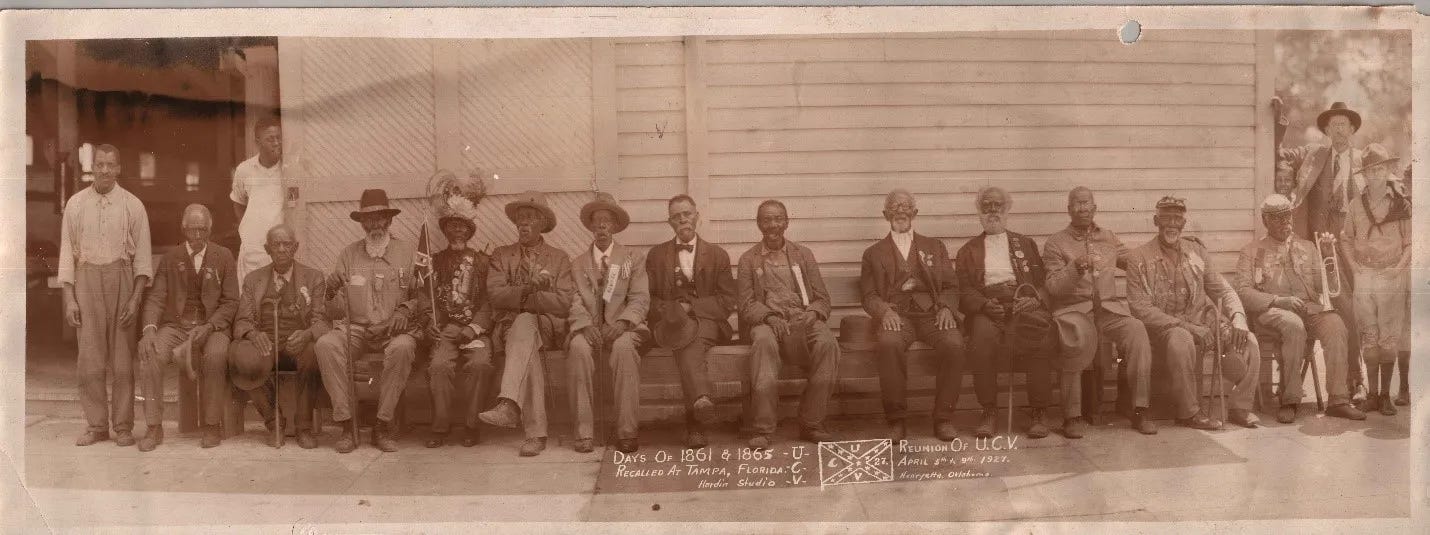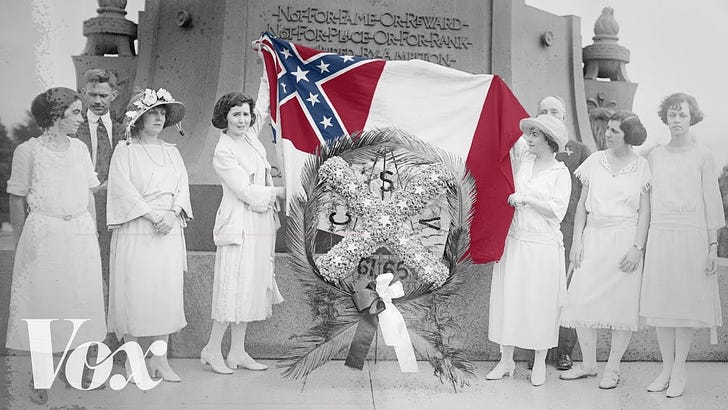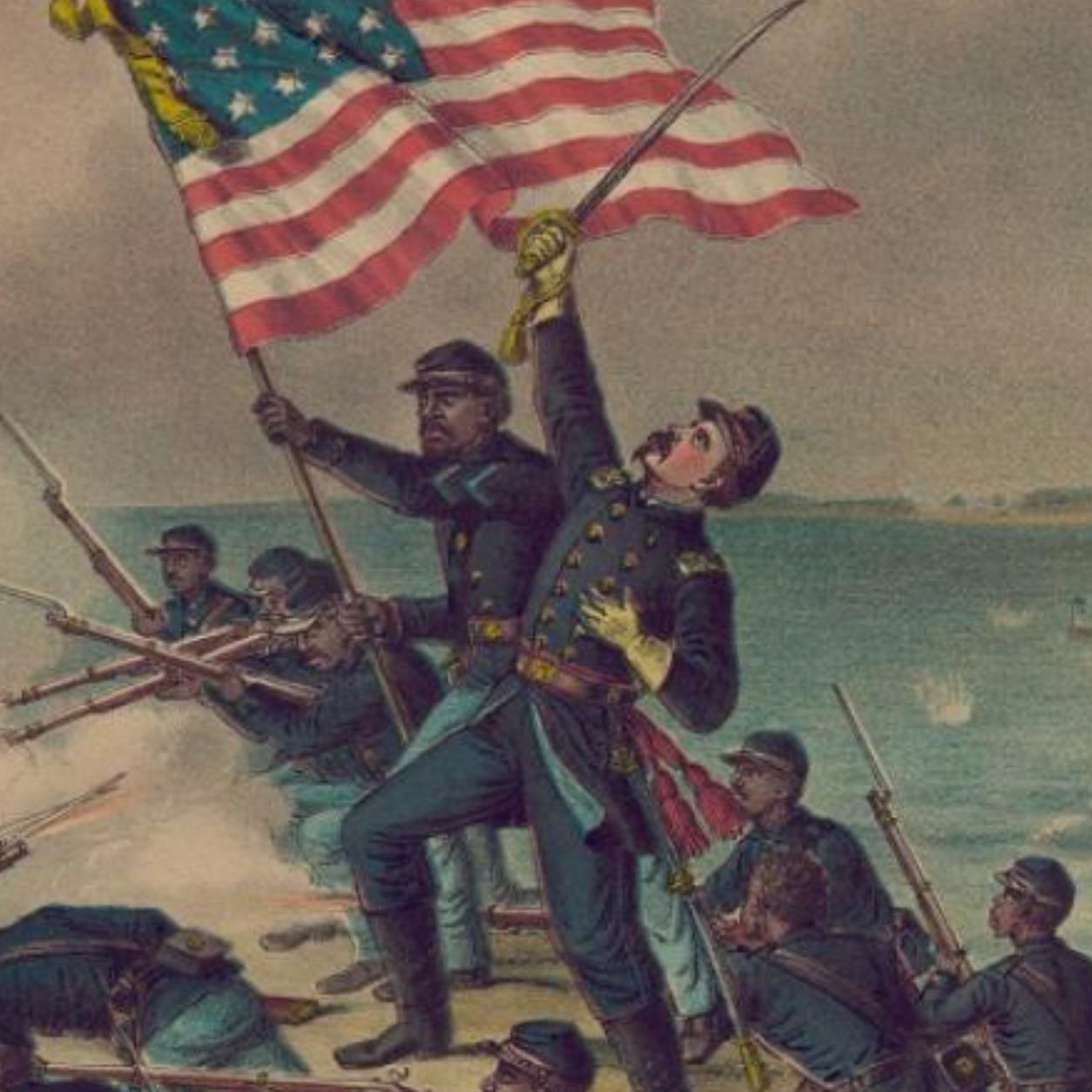In the early twentieth century, the United Daughters of the Confederacy exercised a great deal of control over how African-American history was taught and remembered (if at all) throughout much of the country. They did this, in large part, by controlling the history textbooks that children used in school. Their Lost Cause narrative emphasized peaceful race relations before the Civil War and an uwavering “loyalty” on the part of enslaved people to their enslavers and to the Confederacy right through to the end of the war.
Their efforts helped to solidify this narrative into the collective memory of white America for generations.
African Americans, who accompanied their enslavers to war as body servants also provided a much appreciated boost to this Lost Cause myth. They attended veterans reunions and other events, often in large numbers. These men entertained large white crowds with stories about their brave white fathers and grandfathers even as the steered clear of any mention of the Confederacy’s commitment to creating an independent slaveholding republic.

The willingness of Black men to join their former oppressors reinforced white control over the history of the Civil War and slavery, not only in books, but through the dedication of monuments as well.
Neo-Confederates, who turned stories of loyal body servants into loyal Black Confederate soldiers in the 1970s, continued to seek out and embrace African Americans to do their work of promoting the Lost Cause.
At one time, H.K. Edgerton could be found in his Confederate uniform and carrying a Confederate flag as he entertained white crowds about the glory of the “Old South.”
In 2020, the Sons of Confederate Veterans posted a video of a young Black man, who celebrates both his Black Confederate ancestor and his Conservative principles of limite government.
Efforts to appropriate Black history, within the neo-Confederate community, has traditionally picked up steam during Black History Month. The removal of hundreds of Confederate monuments and other symbols of the Confederacy in public spaces, however, has only served to remind them of their increasingly precarious place in the debate over how American history and Black history specifically should be taught and understood.
Black History Month has increasingly served to remind them of their limited influence over popular memory of the past.
I was reminded of this while perusing my Twitter/X account. Though I no longer post there, I maintain it to keep track of what people are saying and discussing about certain issues, including the Black Confederate myth.
I was struck by this tweet, which was posted on February 1, by a neo-Confederate group called the New Jersey Flaggers.
Once again, it is an attempt to use a young African-American man to promote their preferred narrative. Notice, however, that in this case it is AI-generated. The thumb of his right hand looks like a fifth finger and his left hand is not visible at all. The flag is also clearly problematic as well as the uniform and kepi.
Perhaps it now reflects the inability to easily find African Americans who are willing to dress up to promote a pro-Confederate narrative. But if the doctored image is a reason for optimism, the text is even more so.
It wasn’t that long ago that you could find political support for the neo-Confederate project among Democrats and Republicans. In recent years, however, it has been Republicans who continue to voice support for Confederate memory, but the text of this tweet suggests that even that has begun to slacken.
When Carter G. Woodson launched Negro History Week back in 1926, he was pushing back against a deeply-embedded and widely embraced Lost Cause narrative that rendered African Americans as merely an extension of white America.
Another way to put it is that Black history was viewed as a means to maintaining or justifying white control in the Jim Crow South. After all, if African Americans remained loyal to their enslavers and the Confederacy, than it was justified to relegate them to second-class citizenship.
It’s easy to lose hope at moments like this. Debates over history and how history should be taught will likely continue over the next four years and divide Americans even further. That said, I remain optimistic.
I think Woodson would be thrilled by the incredible amount of Black history that is now available and that continues to shape our understanding of this nation. You can now find it in classrooms across the country, in the form of new monuments that are gradually redefining our public spaces, and on the bookshelves of our neighborhood bookstores.
I can’t think of a better time to learn about the rich history of this country in all of its magnificent color.







Wow! Thanks so much as always for your work and writing!!
If I may, I wanted to share an experience I recently had while on a research trip to Knoxville, TN. I was visiting an archive and speaking to the archivist who worked there and I can't exactly remember the context that it came up in but the person told me "Oh no, see Knoxville is a unique place. During the Civil War, we were part of the Union." And in response, I said, "I've seen a lot of Confederate monuments around here. Do you know why there are so many?" Part of my research does include looking at the historical memory of Knoxville. I'll be honest the archivist got upset and had nothing to say. This was my second trip there and during my first trip I located many of these monuments and there are many!! I've noticed during the Civil Rights era there are newspapers celebrating Knoxville's early integration efforts but others printed at the same time declaring Knoxville did not want integration. It's interesting. (Sorry for such a long comment)
Kevin,
This is great. I have decided that for a time in February I am focusing my Substack articles on Black history to push back against the attempts of the Trump administration to erase Black history from our memory. These people are fearful and potentially violent.
Keep up your work. I always share it on other venues and with friends.
Resistance is not futile.
Peace and watch your six,
Steve Dundas